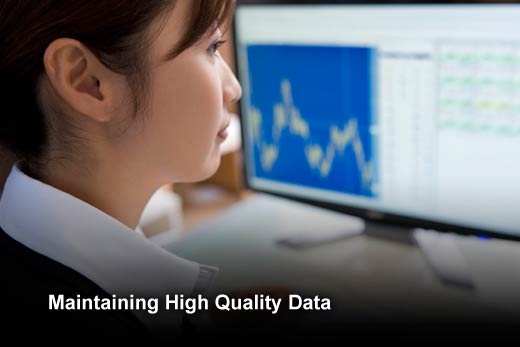Analyzing large amounts of data across a multitude of business systems enables companies to optimize the performance of the sales team, identify patterns in the industry, or determine the efficacy of marketing. A variety of tools enable organizations to prepare the data, but if the quality is insufficient, it will provide unreliable insights.
Data connectivity and integration can be affected by a variety of factors including how it is entered, stored and managed. Maintaining high-quality data is reliant on regular updating, standardization and de-duplication. However, if these processes are flawed, the data can negatively sway organizational spend and productivity. When evaluating the quality of your organization’s data, a variety of characteristics need to be assessed.
In this slideshow, Paul Nashawaty, director of product marketing and strategy at Progress, looks at key factors organizations must consider to ensure their data remains of high quality.
Maintaining High Quality Data
Click through for five key factors organizations need to consider to ensure their data quality remains high and reliable, as identified by Paul Nashawaty, director of product marketing and strategy at Progress.
Accessibility and Consistency
As data volume, velocity, variability and variety increase, so do the stresses on today’s software infrastructures when they can no longer make sense of data deluge. In a well-written, well-tuned application, over 90 percent of data access time is spent in middleware. And data connectivity middleware plays a critical role in how the application client, network and database resources are utilized. In any bulk load use case scenario, database connectivity is the cornerstone of performance. Over the years, technology vendors have made great strides in database optimization as well as the performance of processors and other hardware-based server components. As a result, the bottleneck migrated to the database middleware.
Relevance, Accuracy, and Completeness
The challenge in dealing with this extraordinary deluge of information is having the ability to quickly and easily access it, on any device, from any location, at any time. By fully optimizing your data connectivity, you can generate a positive domino effect that improves the performance of your organization across the board. Apps can be snappier with decreased load times, improving user experience. Data can be accessed and analyzed faster, meaning you can act quickly on the latest insights for better decision making. Anytime/anywhere connectivity gives you the ability and the agility to adjust on the fly to meet continually changing customer needs and fluctuating marketplace demands.
Security
When working with Big Data, security should be a priority. Several high-profile data breaches in government, retail and banking in the past few years have made this threat very real. In this new world where every detail of our lives can be recorded and stored in databases, the organizations collecting that data have a responsibility to protect their customers. Here are some of the ways that companies can protect themselves when dealing with Big Data:
- Define responsibilities for both the cloud services provider and the cloud services user regarding specific data privacy controls that are required.
- Perform ongoing monitoring and audits of cloud services and consistently review any relevant metrics that indicate levels of data integrity, confidentiality and availability.
- Encourage and invite consumers to access, review and correct information that has been collected about them.
Transferring
Until recently, there have been very few challengers to relational databases like SQL Server, which have reigned supreme for nearly 50 years. Now, traditional relational databases find themselves being replaced by newcomers like MongoDB, Cassandra and Hadoop along with non-relational, NoSQL, NewSQL and Big Data options. These new technologies have a lot to offer but don’t always play nice with existing systems and applications that were built with relational models in mind.
Firms that are starting to migrate to new technology need to future-proof their environments by finding a ‘connector-tolerant’ application to ensure seamless connectivity with a multitude of sources such as MongoDB, SparkSQL, Hadoop, etc. The faster organizations can move data for analysis, the faster they can free up the storage required to house the information at the collection points, cutting down on storage costs and management.
Performance and Scalability
There is an enormous amount of data in our digital world, and companies continue to struggle with what to do with it. One thing we do know is that the amount of data generation shows no signs of slowing. As the quantity continues to grow, performance becomes a bigger and bigger problem. Algorithms and software systems must retrieve and process data at exceptional speed: Every millisecond counts.
Performance of these systems determines how fast we can mine the data, how fast we can make use of it, translate it, transform it, analyze it, and use it to make decisions. The cloud offers a convenient solution for addressing these concerns and also offering pay-as-you-go models, so businesses only pay for what they use, providing enormous flexibility and scale.








